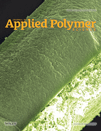Flame-retardant and morphological analysis of nitrogen heterocycle-modified poly(vinyl alcohol) and their application for adsorption of heavy metal ions
Abstract
The functional modification of poly (vinyl alcohol) (PVA) was conducted through phosphorus containing nitrogen heterocycles. This has been believed to have extensive thermal stability and heavy metal ion adsorption in the area of polymers. The heterocyclic modified polymers were characterized by Infra red (FTIR), Nuclear magnetic resonance spectroscopy, and elemental analysis. Thermogravimetric analysis studies displayed that phosphorus-containing five membered and fused heterocyclic based PVA were less thermally stable than six membered compounds. Differential scanning calorimetric studies reported that the glass transition and melting point temperature of the heterocyclic modified PVA was higher than the pure PVA. X-ray diffraction studies were done to analyze the structure of the modified polymer. Atomic force microscopy surface scans showed that the modified polymeric surface was found to have rough in micrometer scale. Modified PVA showed improved thermal stability, flame retardance, organosolubility, and surface roughness. The adsorption capacities of the modified PVA were determined for several heavy metal ions with the variation of pH. The adsorption capacity was found as 289 mg Pd2+/g of imidazole modified PVA and exhibited higher than other modified PVA. © 2013 Wiley Periodicals, Inc. J. Appl. Polym. Sci., 2013




